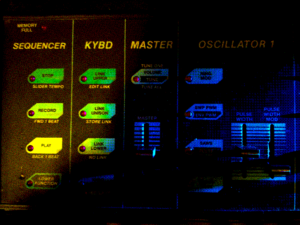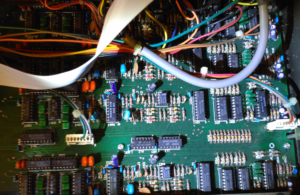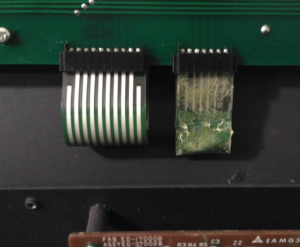I want to dedicate my first post to a machine that I’ve loved very much, even if it has given me lots of troubles and..well, it still does every time I dare to touch it!
Just starting from its name, things are pretty weird.. On its back panel there’s a metal label with Fender written on it, that looks suspiciously similar to my guitar amp one’s. Something never seen on a synth, before! :D
An other pretty strange thing, is the Portamento ON/OFF switch activated by the pedal, a useful but pretty unusual design.
When you try to rise it from its stands, it reminds you clearly the reason of its Rhodes name (yes, its complete name is Fender Rhodes Chroma Polaris, there should be an ARP too..)..it’s so heavy! Anyone aged enough to have toured with a vintage Rhodes electric piano, knows about the heavy weight and the sacrifice needed to carry it around, obviously having the mechanics of a real piano it’s heavy..but the Polaris is an electronic device! Opening my Polaris for the first time, I remember of having searched for the alleged lead bars, I imagined they had put by design, to increase the image of solidity of the product! :D
The Polaris is an analog/digital hyb rid, where an analog CEM chips based, 2 oscillators/channel, 6 voices of polyphony, 24dB filter synth engine, is computer controlled by a 80186 microprocessor, giving amazing features for the beginning of the 80s standards.
rid, where an analog CEM chips based, 2 oscillators/channel, 6 voices of polyphony, 24dB filter synth engine, is computer controlled by a 80186 microprocessor, giving amazing features for the beginning of the 80s standards.
It had 132 preset memories (100 more than a Jupiter 6), MIDI, keyboards velocity control, Internal 12 steps polyphonic sequencer and the sounding juicy characteristic: Extra fast envelopes, giving attacks as sharp as the recently before born digital FM, DX7.
The project was a cut down, cheaper version of the original Chroma synth developed by ARP, the company known to the public for the epic synthesizer present in “Close Encounters of the Third Kind“, too. It’s development suffered several problems as ARP closed and was absorbed by CBS, the owners of Fender Rhodes. The project started under Paul DeRocco and was almost completed when CBS decided to pass it to Rhodes, leaving the team with much less advertisements funds, in a moment when digital was surging as the new standard with the Yamaha DX7, Oberheim and Sequential Circuits were still at the top of the sales while Roland and Korg were offering alternatives at lower prices (Juno 106, Poly 800). The Polaris hasn’t been commercially too successful, but was still a very good synth with a distinct character.

http://en.wikipedia.org/wiki/CEM_and_SSM_chips_in_synthesizers
I should have get rid of it, when long time ago, it was officially diagnosed dead by my synth tech center. I sure overestimated my qualities as repairer, even so what was really needed more then a tech, was a necromancer!

The most common fail on the Polaris is the connection from the front panel to the PCB. The plastic film that holds the tiny copper connections, tend to dry with the years and brake, making the editing possible only through MIDI.
Not a big problem today, as we have free MIDI editors and cheap programmable control surfaces that can solve the problem. But mine unfortunately was victim of a flooding and some drops of water entered in it, making it literally drowning. Its synth soul abandoned it, but its corpse started having a new life, reacting to MIDI inputs, but in the funniest way possible! From there its nickname, Zombie Polaris.
When the mood is cool and in full moon, it is capable of such dreadful howls!


Weight equals quality lol!
Those sounds you’ve conjured out of its corpse sound fantastic though, you are indeed a synth witchdoctor:)
:D Many thanks Spira, so glad you enjoyed the reading! :)
That’s an awesome Zombie Polaris soundtrack. I’ve had one for years and it’s in great shape… or was, till I opened her up to change the battery (rerouted to external box) and when I revved her back up, most of the membrane switches in the program storage matrix failed. I’m assuming it’s a broken ribbon. I was wondering – did you get rid of the beast or if you kept it, what controller are you using as an editor? Thanks, Gary.
Many thanks, Gary! I’m so glad you liked it! Your Polaris problem is pretty common. If interested in repair it, Paul De Rocco, the main synthesizer’s engineer, still sells kits for the repair. You can find them on eBay.com under the title “Chroma Polaris membrane switch panels”. Regarding the use of editors, MIDI Quest has a good layout for the Polaris but being this program in my opinion too expensive, I hadn’t try it yet. Good luck!
I ordered the membranes. There is one key that wants to stick on me – doesn’t return very snappily. I guess I’ll see if I can get in there to tweak/clean. I use a master controller most of the time anyway. I’ve got a few more dinos to unpack from storage and probably a few more batteries to replace. That Crumar Spirit sounds great. I have a Crumar Performer – did have a Crumar organ, but alas. Cheers.
Good luck with your Polaris repair! Maybe you know it already but there is a Polaris Group on Yahoo with lots of information that can be very useful: https://groups.yahoo.com/neo/groups/chromapolaris/info
I had a Performer too and loved it very much! :)